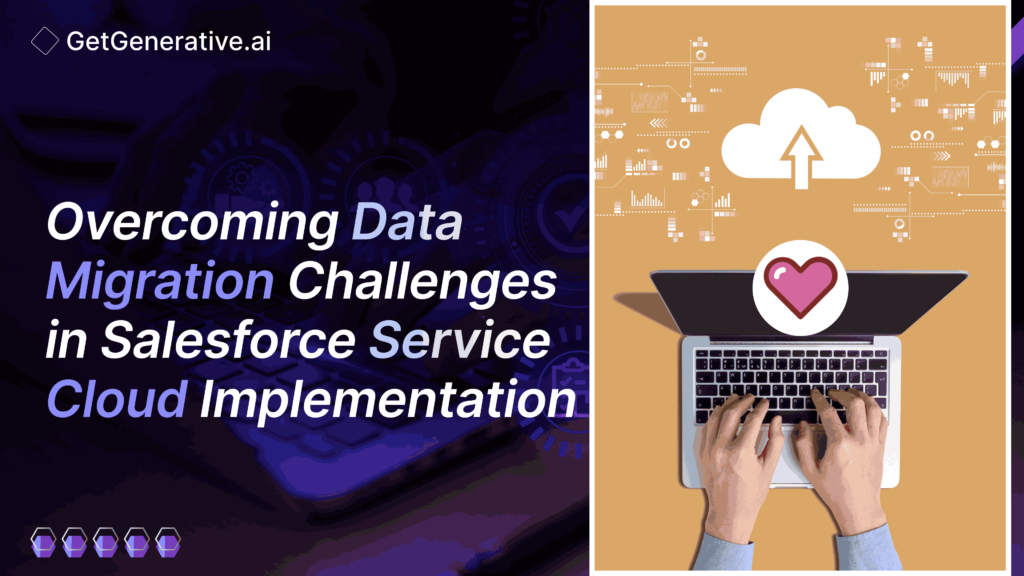Overcoming Data Migration Challenges in Salesforce Service Cloud Implementation
Migrating to Salesforce Service Cloud comes with its fair share of complexities. From data quality issues to compliance concerns, understanding the challenges and implementing effective strategies is crucial to ensuring a successful migration.
In this guide, we’ll explore common Challenges and offer actionable solutions to help your organization navigate the journey smoothly.
Top Common Data Migration Challenges
1. Data Quality Issues
High-quality data is the foundation of any successful migration. Unfortunately, data from legacy systems often presents several problems:
Inconsistent Data Formats
- Variations in date formats (e.g., MM/DD/YYYY vs. DD/MM/YYYY).
- Different phone number structures (e.g., with/without country codes).
- Inconsistent naming conventions (e.g., “Inc.” vs. “Incorporated”).
Duplicate Records
- Multiple profiles for the same customer.
- Redundant case records across systems.
- Overlapping service histories.
Incomplete Data
- Missing critical information like email addresses or phone numbers.
- Partial case histories or customer interactions.
- Broken relationships between related records (e.g., accounts and contacts).
Also Read – Salesforce Data Migration Tools: A Comprehensive Guide
2. Complex Legacy Systems Integration
Migrating from legacy systems often uncovers technical hurdles:
Incompatible Data Structures
- Differences in field types, lengths, and values.
- Custom fields that don’t align with Salesforce.
- Complex relationships that are difficult to replicate.
Technical Limitations
- Outdated APIs or lack of API access.
- Limited export capabilities for large datasets.
- Performance issues during large-scale data extraction.
System Dependencies
- Interconnected systems with hidden data relationships.
- Embedded business logic that needs to be re-created.
- Legacy custom integrations that require careful handling.
3. Timeline and Resource Constraints
Project management plays a critical role in migration, but it often faces these hurdles:
Time Management Issues
- Unrealistic deadlines driven by business pressures.
- Ensuring business continuity during migration.
- Coordination across teams in different time zones.
Resource Allocation Problems
- Limited technical expertise for data migration.
- Competing business priorities and budget constraints.
- Insufficient resources for thorough testing.
4. Data Volume and Performance Challenges
Large datasets bring unique challenges that require robust solutions:
Large Dataset Handling
- Processing millions of records efficiently.
- Managing Salesforce API limits.
- Optimizing batch processing and storage capacity.
Performance Impact
- Potential system slowdowns during migration.
- Backup and recovery challenges.
- Network bandwidth limitations affecting transfer speed.
5. Compliance and Security Concerns
Migrating sensitive customer data demands stringent adherence to regulations and security protocols:
Data Protection Requirements
- Compliance with GDPR, HIPAA, or CCPA.
- Maintaining encryption and audit trails.
- Ensuring industry-specific regulatory adherence.
Security Protocols
- Implementing secure data transfer methods.
- Controlling access during the migration process.
- Safeguarding sensitive customer information.
6. Business Process Alignment
Ensuring business continuity during migration involves addressing these challenges:
Process Mapping Difficulties
- Aligning existing workflows with Salesforce processes.
- Preserving service level agreements (SLAs).
- Adapting custom business rules to new limitations.
Change Management
- Training users on the new system.
- Documenting updated processes.
- Communicating changes effectively to stakeholders.
7. Data Validation and Testing
Thorough validation and testing are critical to a successful migration:
Testing Complexity
- Designing comprehensive test scenarios.
- Validating relationships between data fields.
- Testing performance under load conditions.
Quality Assurance
- Balancing automated and manual testing.
- Pinpointing unique edge cases and identifying potential regression problems.
- Confirming that the migrated data adheres to predefined quality benchmarks.
8. Addressing Post-Migration Issues
Even after completing the migration, organizations may encounter unforeseen challenges that require prompt attention.
Data Reconciliation
- Verifying the completeness of migrated data.
- Fixing broken relationships or missing records.
- Resolving any failed migration attempts.
System Optimization
- Performance tuning for queries and indexes.
- Managing storage efficiently.
- Monitoring system performance to ensure reliability.
Also Read – Salesforce Service Cloud Implementation Guide
Strategies for Overcoming Migration Challenges
Successfully migrating to Salesforce Service Cloud requires a proactive approach. Here’s how you can address these challenges:
- Conduct a Comprehensive Pre-Migration Assessment: Review and evaluate your existing data to ensure its accuracy, consistency, and completeness.
- Design Detailed Migration Plans: Develop a well-structured roadmap outlining timelines, milestones, and assigned responsibilities.
- Implement Rigorous Testing Processes: Leverage sandbox environments to thoroughly test and validate the migration process.
- Foster Clear Communication: Keep all stakeholders well-informed and aligned throughout the migration journey.
- Allocate Sufficient Resources and Time: Invest in skilled professionals and realistic timelines for migration.
- Use Appropriate Migration Tools and Technologies: Leverage tools like Salesforce Data Loader, MuleSoft, or Informatica.
- Create Contingency Plans for Potential Issues: Prepare for unexpected challenges with backup plans and support.
- Establish Clear Success Criteria and Metrics: Define what a successful migration looks like for your organization.
Also, Read – Salesforce CRM Implementation With AI – The Ultimate Guide
Conclusion
Migrating to Salesforce Service Cloud may seem daunting, but with careful planning and execution, these challenges can be effectively addressed. By understanding potential roadblocks and implementing tailored strategies, your organization can ensure a seamless transition, paving the way for enhanced customer service and operational efficiency.
To learn more, visit GetGenerative.ai today!
FAQs
1. What are the most common challenges in Salesforce Service Cloud migration?
Challenges such as data inconsistencies, the complexities of integrating legacy systems, and adhering to compliance requirements are among the most frequent challenges encountered.
2. How can I ensure data integrity during migration?
Thorough validation, testing, and maintaining a robust backup strategy are key to ensuring data integrity.
3. What tools can help simplify data migration?
Salesforce Data Loader, MuleSoft, and Informatica are popular tools for efficient data migration.




